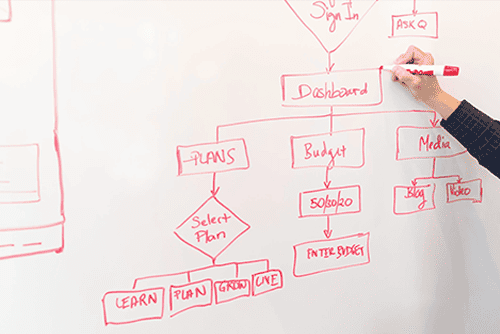How To Calculate Overhead Costs In 3 Easy Steps
To paraphrase a familiar expression: Nothing is certain but death, taxes, and ov...

If your business depends on distinct projects for its livelihood, job costing is an essential step in keeping your bottom line in the black.
But what is job costing, and why is it so important?
In this article, our experts at Sling answer those questions, provide a step-by-step guide for calculating costs, and reveal the best way to produce a better job costing analysis.
Job costing (a.k.a. project-based accounting) is the process of tracking costs and revenue for an individual project and using that information as a basis for estimating the expenses associated with future projects.
Though job costing can be used to gain insight into the profitability and workflow of any business, project-based industries — such as law firms, construction companies, and consulting firms — will benefit most from these numbers.

Deciding what to charge for a product, project, or service is key to the overall success of your business.
Accurate job costing provides a number of important benefits, including:
Even if your business doesn’t rely on distinct projects for its livelihood, job costing can reveal ways to cut expenses, improve your workflow, and increase profits in your bottom line.

Now that you know a bit about the ins and outs of job costing, let’s turn our attention to the process that makes it possible.
Here are the steps for creating an accurate and effective breakdown for any project that comes your way.
The first step in the process is to calculate one of the largest expenses your business is likely to face: labor.
To get to the heart of your labor expenses, you’ll need to know the Actual Hourly Labor Cost of each employee who will work on the project.
That entails crunching such numbers as:
It takes a bit of doing to get to the final variable — actual hourly labor cost — but you’ll learn a lot about the labor expenses that go into keeping your business running along the way.
Here are the necessary formulas.
Gross Pay = Pay Rate x Gross Hours
Hours Not Worked = Days Missed Per Year x Number Of Hours In A Shift
Net Hours Worked = Gross Hours – Hours Not Worked
Annual Payroll Labor Cost = Gross Pay + Other Annual Costs
Actual Hourly Labor Cost = Annual Payroll Labor Cost / Net Hours Worked
To help you understand how all this information works together to yield a number that affects your process, let’s work through the hypothetical example of Employee A who will be working on the new project.
Employee A works full-time at a rate of $20/hour, so their Gross Hours will be 2,080 per year and their Gross Pay will be $41,600 (Pay Rate x Gross Hours).
The previous year, Employee A received 80 hours of time off (Days Missed Per Year x Number Of Hours In A Shift) for holidays, vacation days, and illness days. Using that number as a benchmark, you can estimate that their Net Hours Worked for this year will be 2,000 (Gross Hours – Hours Not Worked).
Add in the Other Annual Costs associated with paying Employee A — benefits, taxes, and insurance comes to $4,000 — and you get an Annual Payroll Labor Cost of $45,600 (Gross Pay + Other Annual Costs).
When all is said and done, then, you calculate that Employee A’s Actual Hourly Labor Cost is $22.80 per hour (Annual Payroll Labor Cost / Net Hours Worked).
With that number in mind for each employee who will work on the project, you can produce an accurate and effective analysis that will keep your business in the black.

Material costs are the total cost of materials used to manufacture a product, provide a service, or complete a project.
You can calculate these expenses by examining financial statements from previous years and doing a deep dive into your inventory reports.
This step is pretty straightforward — adding up all expenses associated with materials you used, or will use, on a project — so we’ll get right to the numbers we’ll use in the final step of our job costing analysis.
After examining your inventory reports, you discover that, on a previous project, your team accrued $20,000 in material costs.
Step four of this process will put that number to use. But, for now, let’s move on to the third variable in our job costing equation
Overhead costs are recurring expenses that sustain your business but don’t contribute to income.
These costs can be divided into fixed, variable, and semi-variable expenses and include the likes of:
To calculate overhead, first determine your monthly costs by adding up all the overhead expenses your business accrues in one month. From there, extrapolate out to the number of months you think the new project will take.
For example, let’s say that your business spends $2,000 per month on overhead. With that number in mind, you now know that total overhead costs for a four-month project will add up to $8,000.

With the three key variables — labor cost, material cost, and overhead — in hand, it’s now time to calculate the total job cost.
The formula for this final step is very simple:
Total Job Cost = Labor Cost + Material Cost + Overhead
As you can see, most of the hard work is done before you reach this final step, and a job costing analysis is pretty much finished when you have numbers for all three variables.
The only thing that’s left to do is add the numbers together to get the total cost for the job. For this example, we’ll assume that there’s only one employee — Employee A — working on the project.
We’ll also assume that Employee A will work 40 hours per week and that the project will last for one month (160 hours total).
Total Job Cost = (160 hours x $22.80 per hour) + $20,000 + $2,000
Total Job Cost = $25,648
With that analysis in hand, you know that you would need to charge the client $25,648 to break even. Add in a bit for profit and you’re good to go.

Now that you’ve got the basic steps involved in job costing, let’s put the variables together in a real-world example to see how it all works.
Let’s say a mechanical keyboard manufacturer wants to win a one-time contract to make 1,000 special keyboards for a particular client and they need to figure out the job cost so they know how much to bid.
The manufacturer puts together a team of 10 employees and plans on giving them eight weeks (40 business days) to assemble the units.
The team is composed of:
The project manager will work full time (five days per week) at a rate of $400 per day.
The two warehouse managers and the two supply chain managers will work part-time (three days per week) at $300 per day.
The five assembly employees will work full-time (five days per week) at $200 per day.
The manufacturer’s labor costs total:
Labor cost for the potential keyboard project totals $70,400.
The keyboard manufacturer assembles everything in-house, but they need to purchase the individual components from their suppliers, including:
These items are grouped into a category called “direct material costs” and total $20,000.
The manufacturer also factors in indirect material costs for new tools and any office supplies they might need along the way, adding another $10,000 to the total.
Material costs for the potential keyboard project totals $30,000.
To round out their job costing estimate for the new project, the keyboard manufacturer includes the overhead costs it will accrue during the eight-week operation.
Their overhead costs include:
All told, the manufacturer calculates $10,000 per month for all overhead.
Overhead costs for the potential keyboard project totals $20,000.
Adding up all of the variables, the manufacturer gets:
$70,400 (labor costs) + $30,000 (material costs) + $20,000 (overhead costs) = $120,400
From there, they add in roughly 10% for profit margin ($12,000) and decide to submit a total bid of $132,400 for the project.
Though this example shows how job costing can be used to create an estimate of future activity (the bid the keyboard manufacturer submitted), it can also be used to analyze past activity.
Let’s say that the keyboard manufacturer won the bid, produced the 1,000 units, and shipped them out to the customer. After all was said and done, their total cost for the project was $133,000.
With both the starting estimate and the final number, the company can dig into actual expenses (labor, materials, and overhead) to see where the overage occurred (let’s say some of the assembly crew had to work overtime several times during the project).
In future project estimates, the manufacturer can either build that overtime number into the bid or take steps to control overtime throughout the business.
The manufacturer can also analyze what went into the final numbers to figure out how they can refine their workflow to be more productive.

Though job costing and process costing may sound similar, they are two distinct (though still related) calculations you can use to run your business better.
As we explained earlier, job costing is the process of tracking costs and revenue for an individual project and using that information as a basis for estimating the expenses associated with future projects.
Process costing, on the other hand, is the practice of assigning costs to a collection of project outputs over a given time period and using that information to calculate a unit cost.
How does this apply to real-world applications? Let’s examine it in the context of our example of the keyboard manufacturer from the previous section.
The keyboard manufacturer used job costing to create its bid for the special, one-time run of 1,000 keyboards.
They added up the labor, material, and overhead costs that go into production and came up with a final number for the whole run ($132,400).
Imagine that the client loved the keyboards the manufacturer produced and wants to order more on a regular basis.
The manufacturer can use process costing to create a per-unit cost so they know how much to charge the customer when they place an order.
A simple example of this process costing would be using the total final project cost of $133,000 to figure out how much it cost the manufacturer to produce all 1,000 keyboards.
In this example case, the keyboard manufacturer determines that each keyboard costs them $133 to produce.
The entire process of producing a single keyboard from start to finish — including receiving materials and shipping out final products — costs the manufacturer $133.
Now, when the customer orders 2,000 keyboards, the manufacturer has all the data it needs to charge the customer appropriately and give them a time frame for production.
In the case of 2,000 units, the manufacturer knows that:
From there, the keyboard manufacturer can quote production of 2,000 units in four months (twice as long as the 1,000-unit production run) for a final cost of $266,000.
So, rather than producing a job cost estimate for each order, the keyboard manufacturer can use process costing to create a unit price for consistent, large-scale production of this customer’s keyboard.

As a general rule, restaurants don’t use job costing in the strictest sense of the term. They can use similar calculations to figure out how much a specific dish will cost, but that’s not job costing, per se.
Businesses that are more likely to use job costing as described in this article are those in the following industries:
Job costing is extremely common in the construction industry because costs vary widely from job to job.
Construction managers must factor in labor, materials, and overhead just to break even and don’t usually engage in process costing because of the rapid change in any number of their expenses.
Similarly, the engineering industry relies heavily on job costing because the scope and length of their work varies widely from project to project.
For example, an engineering firm may be hired to spend eight months designing a building for a residential construction firm. Or, they may be hired to conduct a multiyear consultancy or supervise a specific public works construction site.
Each of those tasks requires different job costing calculations so that the engineering firm knows what to charge its clients to stay competitive while still being able to pay its bills.

You can implement job costing in your business on your own, but the process can get very complicated very quickly.
We used simple examples in this article to illustrate how it all works and to give you a general idea of how to apply the calculations.
But, to really get a handle on the ins and outs of job costing, consult with an accountant who has knowledge of your industry and who specializes in these niche calculations.
Accurate numbers are important for profitability, and it’s all too easy to make simple mistakes when you undertake job costing on your own.
If your business has a qualified accountant on staff, great. Otherwise, consider hiring an outside accountant to conduct a job costing audit and, perhaps, train you and your staff on how to do the calculations correctly on your own.

Accurate job costing can be the difference between profit and loss for your business.
The best way to manage and lower your overall job costs — and produce the best possible results — is to control the expenses that have the biggest impact on the calculation.
Which expense has the most influence on job costing? Labor.
Labor costs are one of the largest expenses that most businesses face. Get control of your labor budget to maximize and lower your labor costs, and your job costing numbers will follow.
The Sling suite of software tools can help.
Sling gives you incredible control over your schedule so you can quickly and easily create schedules one month, two months, even six months or more in advance.
And the built-in artificial intelligence automatically reminds you of requested time off, double bookings, and overtime hours so there’s less back-and-forth once you’ve completed the schedule.
Sling also acts as a time clock for your business. You can set up a central terminal or allow your employees to clock in and out right from their mobile devices. And with Sling’s powerful geofencing feature, you can prevent early clock-ins and missed clock-outs with the touch of a button.
Sling even lets you optimize labor costs by setting wages per employee or position so you can see how much each shift will cost you. You can keep track of your labor budget and receive alerts when you’re about to exceed those numbers.
This will help you save money, produce accurate job costing, and increase profits. Sling really is the go-to solution for all your scheduling and job costing needs.
For more free resources to help you manage your business better, organize and schedule your team, and track and calculate labor costs, visit GetSling.com today.
This content is for informational purposes and is not intended as legal, tax, HR, or any other professional advice. Please contact an attorney or other professional for specific advice.
See Here For Last Updated Dates: Link
Schedule faster, communicate better, get things done.